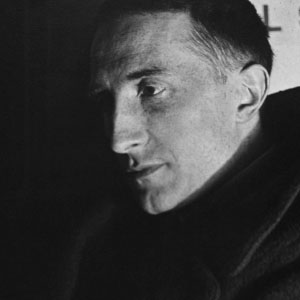
Marcel Duchamp was born in 1887 to a successful notary. Duchamp and his five siblings grew up in Blainville, Normandy. Their young lives were greatly influenced by art, resulting in four of them becoming artists themselves: Marcel, Raymond Duchamp-Villon, Suzanne Duchamp-Crotti, and Jacques Villon. Their grandfather had been an engraver and his art was hung around their childhood home. Duchamp decided at a relatively young age that he wanted to be a painter, and began in a vaguely Post-Impressionist style. In 1904 he joined his older brothers in Paris where he attended the Académie Julian for a year. Here again, he was influenced by Post-Impressionism and Fauvism and some of his earlier work includes the style of Impressionism mixed with the intense colors common in Fauvist works. While he was living in Paris he sold some humorous drawings to support himself.
In 1909 he began exhibiting publically at Salon des Indépendants and the Salon d’Automne. In 1911 he fell in with a Cubist group and painted his first – and possible best – known work called Nude Descending a Staircase No.2. It was rejected from a showing in Paris but accepted to the Armory Show in New York City in 1912, gaining Duchamp fame in the United States. In 1913 he created his first “readymade,” the type of art innovation that would truly put him on the map. It was around this time that Duchamp began to dismiss the idea of “aesthetic art” – or as he called it “retinal art” – and embrace the idea that art should be more intellectually provoking than visually pleasing. His “ready-mades” were based on the premise of undercutting this idea of “retinal art.”
In 1915 Duchamp moved to New York where he was welcomed by artists and intellectual circles because of his fame. Many dealers approached him but he turned them all down because he was not interested in the monetary side of art. Instead he taught French to make a living. While he was there he helped to form New York’s Dada movement. He spent some months during 1918 and 1919 in Argentina before heading back to Paris for a while. He then ended up back in New York until 1923.
He once again returned to Paris and remained there until 1942. His parents had died and subsequently he had come into some money, and so during these years he was free to dedicate himself to chess. He also married during this time, to a woman named Lydie Sarazin-Lavassor, but they divorced soon after. He never really took up art again, but was still seen as a leader, speaker, and influence for the modern art movement. He remarried in 1954 to Alexina Sattler, who had been previously married to Pierre Matisse. He was naturalized in the United States in 1955 and most of his oeuvre resides in the Philadelphia Museum of Art. Though he was not the most prolific artist, he undeniably was one of the most influential of the Twentieth Century.
References
Chilvers, Ian (ed.). The Oxford Dictionary of 20th Century Art. Oxford: Oxford University Press, 1998.
Lucie-Smith, Edward. Late Modern: The visual arts since 1945. New York: Frederick A. Praeger Publishers, 1969
